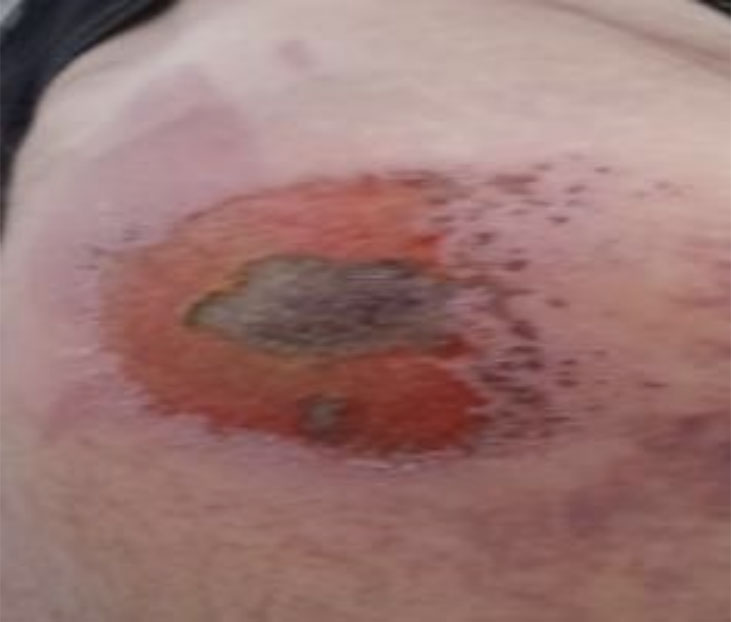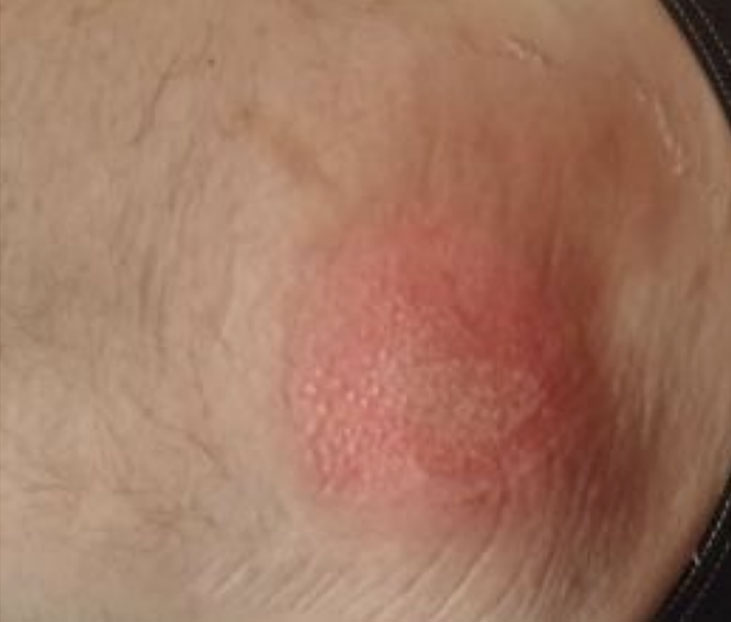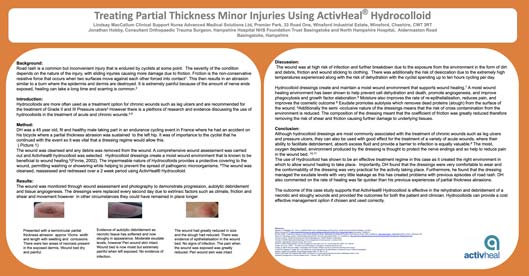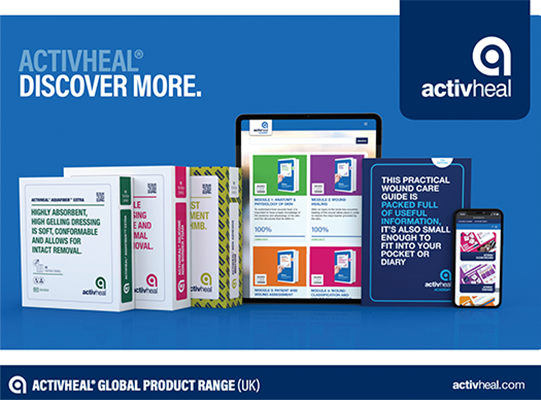Clinical Resource: Treating Partial Thickness Minor Injuries Using ActivHeal® Hydrocolloid
Lindsay MacCallum and Jonathan Hobby
Clinical Support Nurse Advanced Medical Solutions Ltd and Consultant Orthopaedic Trauma Surgeon, Hampshire Hospital NHS Foundation Trust Basingstoke and North Hampshire Hospital
Clinical Resource
Gelling alginate dressings and their contribution to wound management
Lindsay MacCallum and Jonathan Hobby
Clinical Support Nurse Advanced Medical Solutions Ltd and Consultant Orthopaedic Trauma Surgeon, Hampshire Hospital NHS Foundation Trust Basingstoke and North Hampshire Hospital
BACKGROUND
Road rash is a common but inconvenient injury that is endured by cyclists at some point. The severity of the condition depends on the nature of the injury, with sliding injuries causing more damage due to friction. Friction is the non-conservative resistive force that occurs when two surfaces move against each other forced into contact1. This then results in an abrasion similar to a burn where the epidermis and dermis are destroyed. It is extremely painful because of the amount of nerve ends exposed, healing can take a long time and scarring is common2.
INTRODUCTION
Hydrocolloids are more often used as a treatment option for chronic wounds such as leg ulcers and are recommended for the treatment of Grade II and III Pressure ulcers3, however there is a plethora of research and evidence discussing the use of hydrocolloids in the treatment of acute and chronic wounds4,5.
METHOD
DH was a 45 year old, fit and healthy male taking part in an endurance cycling event in France where he had an accident on his bicycle where a partial thickness abrasion was sustained to the left hip. It was of importance to the cyclist that he continued with the event so it was vital that a dressing regime would allow this. (Picture 1)
The wound was cleansed and any debris was removed from the wound. A comprehensive wound assessment was carried out and Activheal® hydrocolloid was selected. Hydrocolloid dressings create a moist wound environment that is known to be beneficial to wound healing5 (Finnie, 2002)7. The impermeable nature of Hydrocolloids provides a protective covering to the wound, permitting washing or showering while helping to prevent the spread of pathogenic microorganisms6. The wound was cleansed, reassessed and redressed over a 2 week period using ActivHeal® Hydrocolloid.

RESULTS
The wound was monitored through wound assessment and photography to demonstrate progression, autolytic debridement and tissue angiogenesis. The dressings were replaced every second day due to extrinsic factors such as climate, friction and shear and movement however in other circumstances they could have remained in place longer.

Presented with a semicircular partial thickness abrasion approx 10cm width and length with swelling and contusions. There were two areas of necrosis present in the exposed dermis. Wound bed dry and painful.

Evidence of autolytic debridement as necrotic tissue has softened and now sloughy in appearance. Moderate exudate levels, however Peri wound skin intact. Wound bed is now moist but extremely painful when left exposed. No evidence of infection.

The wound had greatly reduced in size and the slough had reduced. There was evidence of epithelialisation in the wound bed. No signs of infection. The pain when the wound was exposed was greatly reduced. Peri wound skin was intact.
DISCUSSION
The wound was at high risk of infection and further breakdown due to the exposure from the environment in the form of dirt and debris, friction and wound sticking to clothing. There was additionally the risk of desiccation due to the extremely high temperatures experienced along with the risk of dehydration with the cyclist spending up to ten hours cycling per day.
Hydrocolloid dressings create and maintain a moist wound environment that supports wound healing7. A moist wound healing environment has been shown to help prevent cell dehydration and death, promote angiogenesis, and improve phagocytosis and growth factor elaboration8. Moisture also improves the rate of re-epithelialisation, reduces pain, and improves the cosmetic outcome8. Exudate promotes autolysis which removes dead proteins (slough) from the surface of the wound9. Additionally the semi-occlusive nature of the dressings means that the risk of cross contamination from the environment is reduced. The composition of the dressing meant that the coefficient of friction was greatly reduced therefore removing the risk of shear and friction causing further damage to underlying tissues.
CONCLUSION
The wound was at high risk of infection and further breakdown due to the exposure from the environment in the form of dirt and debris, friction and wound sticking to clothing. There was additionally the risk of desiccation due to the extremely high temperatures experienced along with the risk of dehydration with the cyclist spending up to ten hours cycling per day.
Hydrocolloid dressings create and maintain a moist wound environment that supports wound healing7. A moist wound healing environment has been shown to help prevent cell dehydration and death, promote angiogenesis, and improve phagocytosis and growth factor elaboration8. Moisture also improves the rate of re-epithelialisation, reduces pain, and improves the cosmetic outcome8. Exudate promotes autolysis which removes dead proteins (slough) from the surface of the wound9. Additionally the semi-occlusive nature of the dressings means that the risk of cross contamination from the environment is reduced. The composition of the dressing meant that the coefficient of friction was greatly reduced therefore removing the risk of shear and friction causing further damage to underlying tissues.
References
- Agrawal, A. Raibagkar, S.C. Vora,H.J (2008) Friction burns: Epidemiology and Prevention. Annals of burns and |Fire Disasters. Vol XXI-n
- British Cycling (2015) https://www.britishcycling.org.uk/knowledge/article/izn20140512-All-Cycling-Road-Rash-0 Accessed: 13/08/2015
- EPUAP (2009) Treatment of pressure ulcers:Quick Reference Guide. Washington DC:National Pressure Ulcer Advisory Panel; 2009. Available at: http://www.epuap.org/guidelines/Final_Quick_Treatment.pdf
- Queen D. Technology update: Understanding hydrocolloids. Wounds International 2009; 1 (1). Available at: http://www.woundsinternational.com/article.phpissueid=1&contentid=129&articleid=229
- Thomas S (2010). Surgical Dressings and Wound Management. Cardiff: Medetec Publications.
- Thomas, S (2008) Hydrocolloid dressings in the management of acute wounds: a review of the Literature. International Wound Journal. Vol 5. No 5
- Finnie A. (2002) Hydrocolloids in wound management: pros and cons. Br J Community Nurs 2002; 7(7): 338-42.
- Fonder, M.A et al ( 2007) . Occlusive wound dressings in emergency medicine and acute care.
- Cutting, K (2003) Wound exudate: Composition and functions. British Journal of Community Nursing. Vol 8 Supp 3
CONTACT US FOR MORE INFORMATION
Discover ActivHeal®
Social Media
Our Product Range
AMS Group
ActivHeal®, its logo and the Advanced Medical Solutions logos are registered trademarks of Advanced Medical Solutions Ltd.
Copyright © Advanced Medical Solutions Limited | Design by Lumisi Ltd


